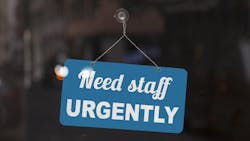Confronting the Great Resignation: How technology can help retain and attract practice staff
As businesses continue adapting to the COVID-19 pandemic, many professionals have been questioning their career choices and priorities. This movement, known as the Great Resignation, shows no signs of slowing down. The Bureau of Labor Statistics reported that 4.5 million Americans quit their jobs in November 2021, surpassing the previous record of 4.3 million departures, which the bureau recorded in September 2021.
This massive shift has dramatically impacted the medical field, including the dental profession. According to the American Dental Association’s Health Policy Institute, 80 percent of dental practice owners reported challenges in hiring or recruiting hygienists and assistants in 2021. The pandemic introduced many pressures: difficult working conditions, inconsistent coronavirus guidance, lack of access to PPE and testing, and ballooning administrative task workloads. With these factors in play, it is no surprise that, of health-care workers who have kept their jobs during the pandemic, 31 percent are considering leaving. In addition, 11% of physicians surveyed in a Medscape study said the pandemic influenced them to retire early.
These developments are not ideal for the dental profession, especially practice owners. In a Becker’s Hospital Review survey, 79% of health-care professionals said staffing shortages had affected them and their workplace. Without essential hygienists, staff, and employed dentists on call, dental practices confront serious operational and continuity obstacles to caring for patients.
Fortunately, practice owners and partners can look to technology to resolve many factors contributing to their stress and employee dissatisfaction. By leveraging appropriate tools and services, dental practices can offer staff the support they need to stay engaged, refreshed, and thriving at work.
Related reading
Why it's time to deal with employee burnout
The Great Resignation: Where it's coming and how the dental industry can avoid it
Managing mounting levels of provider burnout
In all medical specialties, burnout is prevalent—especially today. For example, the AMA found that 42 percent of providers reported experiencing burnout during the height of the pandemic in 2020. These problems have equally impacted dentists as well. The ADA found that 87 percent of dentists under the age of 35 reported feeling anxiety due to coronavirus, with 55 percent reporting feelings of depression. Over time, burnout-related issues can exacerbate poor performance, increase malpractice risk, and result in other critical practice-related problems.
Fifty-six percent of all surveyed providers named excessive paperwork, charting, and other administrative tasks as a primary culprit. The Physicians Foundation discovered in a 2021 survey that 61 percent of physicians continue to report feelings of burnout (greater than the AMA’s findings in 2020), with 57 percent experiencing inappropriate feelings of anxiety, tearfulness, or anger due to COVID. Again, burdensome administrative tasks are listed among the factors contributing to these stresses.
Practices can help reduce task-driven anxiety using healthcare-specific technology and applications. For example, dental practices can use convenient, easy-to-use apps to manage their appointment schedules, track SEO and online review performance, and assign work among their employed dental hygienists. Dashboards can even generate template reports to assist with day-to-day recordkeeping and billing. These tools can empower providers to master various aspects of practice performance with greater ease: track essential performance metrics, manage critical aspects of their practice, and make necessary adjustments in real-time, all without costly distractions.
Addressing front office burnout
In a typical dental office, administrative staff play a key role in steering patients through pre-appointment check-in and intake procedures, acting as patients’ primary contacts for scheduling and initial questions. However, as practices downsize, and experience hiring and recruitment issues, staff members are being asked to do more. As the ADA Health Policy Institute recently found, 44 percent of dentists find it “extremely challenging” to recruit and hire new administrative staff.
Automation can help streamline most of these issues and free up practice staff’s bandwidth. For example, staff can manage online or text message Q&A exchanges with patients, invite patients to complete preappointment forms online, and even offer online appointment booking. These activities can help dental providers satisfy the needs of today’s patients while reducing the administrative workload.
This extends to payment collection, as well. Digital invoicing systems can make it easier for patients to settle their co-pays and outstanding balances using online methods. With PatientPop, for example, doctors can send digital invoices via email and text message without requiring patients to log into any accounts. Ideally, the platform your practice selects should let you view and reconcile patient payments through your EMR or scheduling system—this can help trim your toolset and expenses.
By consolidating these workflows onto a single platform, practice owners can greatly ease demands on staff to help them better meet patients’ preferences and expectations. Instead of operating from a series of silos, your staff can quickly communicate with one another, respond to patient inquiries, modify schedules, and share data either in the office or on the go.
In these still-uncertain times, your practice must maintain staff continuity. By focusing on your employees the same way you focus on patients, you can help ensure that personnel remain steadfast and motivated to pull your practice through whatever challenges you face. Technology, particularly automated tools, serves as the way forward for dentists to manage burnout, retain and attract staff, and keep up morale during these turbulent times.
About the Author
Arman Samani
Arman Samani drives product strategy, innovation, and technology solutions to help practices succeed in the changing health-care landscape. He brings decades of health-care experience in product research, strategy, and delivery to PatientPop.
